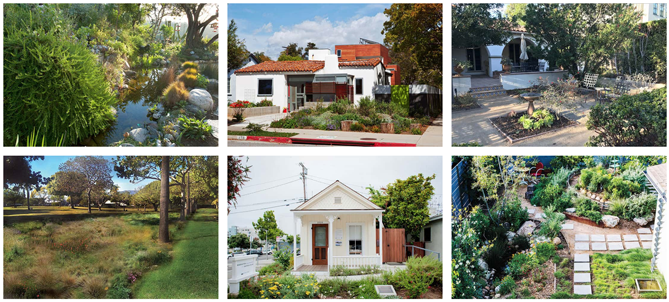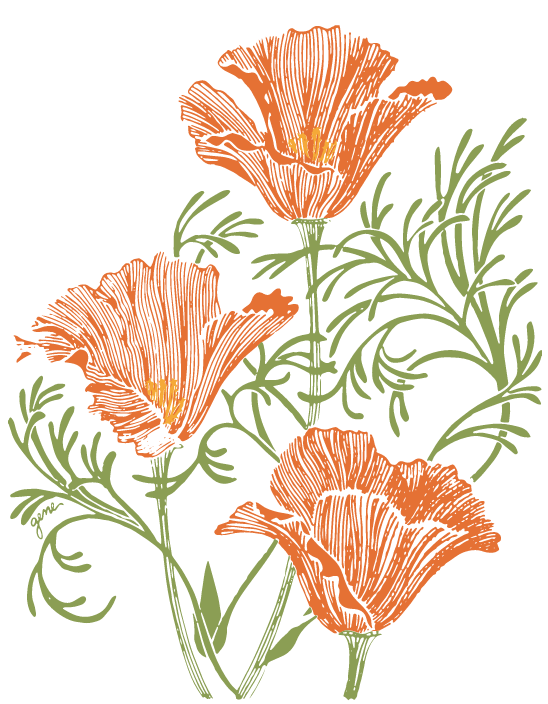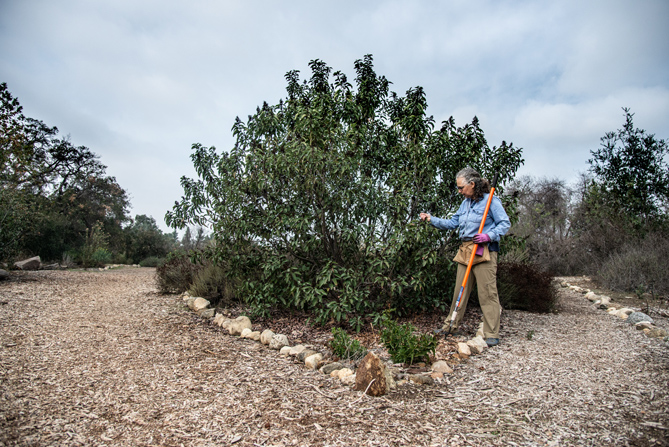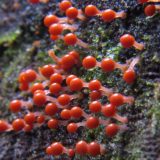
There’s a well defined architectural vocabulary house flippers use in our neighborhood. Flippers buy a crumbling 1920s bungalow, paint the front door orange, add a horizontal fence, redo the interior in a Home Depot meets Dwell Magazine style and then turn around and sell it for a million bucks.
When house flippers tackle a yard they tend towards the “low-maintenance” landscape (in quotes because there’s no such thing as a low-maintenance garden). One of the favorite tools in the flipper landscaping toolbox is decomposed granite (DG) used as a mulch. Put some plastic landscape fabric down (blocks rainwater in our climate, fyi) and top that plastic with DG. They then punch some holes in the DG/plastic and pop in succulents and maybe a rosemary bush or two. By the time the yard becomes a sad, desertified tangle of unhappy succulents and crabgrass, the flippers are long gone.
I’ve got a big issue with DG as mulch. In order for DG to look good, it’s got to be compacted and soil compaction is really bad for plants, including hardy natives and succulents. It stifles the life of the soil, and does not build new soil. And eventually, the plastic will fail, and the weeds will come through (some come through even when the plastic is new), and whoever is left holding the bag a couple of years down the road will be pulling decaying bits of plastic out of their garden for evermore.
What’s a better approach? Wood chips. Pile it on thick. Skip the plastic liner. Eventually your new plantings will cover any bare areas if you space them correctly. It looks good, and the mulch breaks down and turns into soil. You will still need to weed but that’s called gardening. Save the DG for walkways. Or use mulch on your walkways too. Mulch is free or low cost. Just ask your local arborist to drop off a load.





I can report that the trend around here is to use wood mulches even around trees, piling it about 6″ up the trunk so that it looks like the tree is erupting from a tiny wood mulch volcano. This makes Mike McGrath of “You Bet Your Garden” and former “Organic Gardening” editor just nuts. (Hint: you should never mulch up to the trunk of a tree. Those big roots that lie on the surface of the ground need to be on the surface.) In my area, this is more commonly found around the more expensive homes, just another sign that money does not equal smarts.
Yes, the infamous mulch volcano: http://blogs.extension.org/gardenprofessors/2009/08/06/mulch-volcanoes/.
Yup – either the “mulch volcano” or the infamous lets-plant-a-ring-of-big-box-store-annual-posies-around-the-root-crown-of-the-tree + new layer of sod = curb appeal look.
I had to completely redo some of the otherwise wonderful river rock garden work in a section of our japanese landscaped front yard (the previous owners having been, in fact, japanese-american landscape designers) because of disovering the dreaded layer of decaying plastic lurking underneath the whole shebang. And yes, the cure for that, plus the dirt-only underneath much of the landscaping in the backyard has been refreshing the woodchip mulch layer about twice a year. The water usage has gone way down, the soil quality way up, the plants much happier, much easier to weed. Happier for the worms and birds. And this year – the squirrels are happily harvesting baseball-sized mouthfuls-at-a-time of our shredded mulch for nesting material.
Now if I could only get dh to let go of the fantasies that the huge swath of korean grass under conifer trees in the front yard will either ever truly look nice or be waterwise… 😉
FYI, the newly planted, really ugly (for some reason, they used black chips) “low-maintenance” yard at Coronado Terrace and Reservoir is missing a barrel cactus.
Ha! I was waiting for that to happen.
That yard is a cactus thief’s paradise, I gotta say. All those barrel cacti, lined up like little ducks…
Oh man…I’ve been on the receiving end of this landscape flipping ruse..we apparently weren’t thorough enough when evaluating the landscaping of our new prospective house. What we thought was a layer of Wood Mulch And Plastic (bad, but easy enough to remove – plus we could reuse the mulch!) actually turned out to be WMAP placed over a LOAD of topsoil that was dumped over that horrible pink landscape rock, which in turn had dessicated vintage landscape plastic beneath. I swear they had a layer of rock 10″ deep in some spots, compacted with the topsoil. The tortured shrubs were absolutely starved. After 2 years and a lot of pick axing, we’ve ALMOST gotten it all dug out…
Arggh!!!
But I gotta say, it’s worse to be picking out plastic that you yourself put down in your ignorance. 10 years out, and I’m still finding decayed ribbons of plastic and pockets of DG when I’m digging around my yard. I’m haunted by my own hard work of eons past.
Btw – low maintenance garden = established and correctly sited native plantings…
http://goinnative.net/blog/post/3-ways-native-plants-make-gardening-so-much-better
Living in a granite area, having had to pay for radon testing when I moved to my house, I do wonder whether people realise that granite is radioactive? It’s probably on par with bananas, but still I don’t see it mentioned.
I’m trying to think about this as someone who lived in the Phoenix area for a long while, where one can observe no small number of questionable landscaping decisions (i.e. grass).
Wood chips as mulch just doesn’t really describe an appropriate response for yards in that area, but I can’t exactly tell you why other than to point out that wood chips will quickly mummify. Whatever is done, it needs to avoid plastic, and allow access to the deeper soils that support tree, cactus, and succulent growth. I suppose house-flippers aren’t accustomed to thinking about long-term plantings, given that many buyers will either completely redo a yard anyway or completely ignore it.
Ah, the desert is a tricky question. My mom lives in the Phoenix area, and I’m always a bit puzzled when she asks me questions about her yard and her plants.
In turn, I want to ask Gary Nabhan – (http://garynabhan.com )
I realize that this is a very local question, but have you any opinion on the free mulch/chippings that are available in Griffith Park? I occassionally drive past the golf course in the park and there is a mulching facility where they regularly leave out a large pile of mulch and sometimes compost too. I’ve used this in the past because it is free but notice that it can have some bits of plastic in it and lots of stringy filaments from palm fronds. Of course lots of wood and other bits mixed in. Do you purchase your mulch or use the free city offerings?
We’ve used that Griffith park mulch–and it’s fine. I’ve not noticed plastic or too many frond bits before. Maybe that was a rough batch?
We try not to buy mulch. We either get it in the park or get it from arborists–they will often dump a load of chipped trees off in your drive if you ask. Just make sure they have a good chipper and don’t give you a pile of sticks. There’s another city source of mulch down by the river, and that stuff is bad. Stick with the Griffith park pile.
I’ve always hated crushed granite…when it started being used for homes and commercial projects, I initially thought it looked cool, and maybe because it was a new design look…but my problem with it, is, it sticks to shoes and car tires, and the sound of it as you walk on it reminds me of fingernails on the chalkboard! Then you drag it onto other surfaces where it creates more mess….I think it probably works best in a landscape nobody uses…or in magazine photos!
What about (in our area) termites that come with or soon find wood chips. We were told as soon as we bought a house to get all wood chips away from the house, or better yet the yard. The cardboard mulch trend is frowned upon for this reason too, which is kind of a bummer.
Whenever we have a gardening-type question, we type it into Google along with “extension” (UC extension for CA, specifically). So, curious about the termite question I did this and found a study done by the Univ. of Florida extension offices. They tested different types of mulches with termites, and found they ate some kinds of mulch more than others, some wood actually seemed repellant. Their conclusion was that mulch is so valuable in the landscape, and the research on termites and mulch so thin, one may as well mulch and just keep an eye on things.
Well, why am I writing all that out? Here they are:
Further research on mulches and termites is warranted to determine if we should be concerned about using mulch around houses. Also, research is needed on possible repellent mulches such as melaleuca which might serve as an additional barrier for household protection against termites. At this time the benefits of mulches such as water conservation, reduced used of herbicides, and reduced soil erosion are very apparent while the risks to termite infestations due to mulches are unknown. Homeowners will continue to use mulches in landscaping around their houses and buildings. Our current recommendation is to be vigilant and up-to-date with termite inspection and treatment.
http://edis.ifas.ufl.edu/fr075
DG as mulch? I always thought it was for walkways. The local college used it because eventually it hardens up enough that you can roll a wheel chair over it. Or so I have been told. I certainly hope that is the case as I am thinking to use it for my pathways in my yard. Without plastic. I hate the use of plastic on the soil. I would rather pull out the weeds. (I know, crazy, but I will NOT use Round Up or anything else like that, and who knows what the plastic leaches into the soil.)
Watch your arborist. I just had one drop off a load of lovely white birch only to discover (after he’d left) that it also included finely shredded christmas tree lights. Ugh.
If you have chickens, they will gladly eat broken or ground Christmas bulbs. My 4 hens attacked a bulb I broke that was in their water heater. I slapped chickens for five minutes and they jumped all over me as I sheltered the bulb. Finally, I gave up and they ate the bulb and lived.
Here in the South, we are termite heaven. Termites will eat wood in my yard but leave the house alone. All the wood under my house is coated with creosote.
My friends in Birmingham have a theory–all the homes have been treated for so many years that the poison has built up at the foundations and are still effective. However, any wood out from the house-wooden toy, bench, building scraps–will be promptly attacked by termites.
Destructive termites have always been common in my area too.
But I did a lot of reading about whether they are encouraged by woodchips.
I believe the consensus was that woodchips are OK.
I personally think that the dangerous type of termites specialise in tunnelling through large wood pieces, not small chips.
I have spread many truckloads of arborists chips around my yard,
but have not seen termites in the chips.
Though I have seen termites in large logs.
I bought my house very cheaply because half the timber had been eaten out, so they have always been around.
Obviously it pays to be very vigilant under the house and try to stop high moisture there, which our termites thrive on.
That study I mentioned above seemed to indicate that they don’t seem to like redwood, cedar and most especially, melaleuca chips, whereas they think pine is pretty tasty. So maybe its a matter of just choosing the right mulch?
Problem with that is a truckload of Arborist chips is usually a mixture of tree species, and I would find it a bit impractical to be too choosy with what I am given.
The study is very interesting but I think its limitation was that it just tested termites in a petri dish.
Then says
“Subterranean termites consumed mulches in this study. Therefore it seems reasonable that termites can feed on mulches used in landscaping”
But when you look at a woodchip mulch in the garden, there is a multitude of different insects etc, living in it.
No doubt some of them are predators.
So I think it is possible that in the real world a woodchip mulch is not an ideal environment for destructive termites.
Really I haven’t seen a study that says these termites were found eating a garden woodchip mulch.
I found this study here – http://extension.umass.edu/landscape/fact-sheets/formosan-termite – regarding Formosan termites and mulch. Having found the nasty queens last summer in my yard in dead tree roots, I was worried about mulch. Reading the comments here and this report, I feel better. That said, I’m sticking with pine straw. New Orleans sits on limestone, so it adds some acid. Plus, if you had seen those things – termites have multiple queens unlike ants – you would be sure to avoid any chance to see them again. I will not disgust you with a description. I did take a short film and the few friends who saw it could only watch for ten seconds max. Hope ya’ll don’t ever get Formosan Termites.
Beware free wood chips. We covered our last yard in yards of freshly shredded brush and got years of weeding woody little suckers constantly. There was also a quickly-decaying little mushroom that had mycelium everywhere, but it could have just as easily been something much less welcome.
This time we got graded redwood chips, which are behaving much better. There’s already a lot of mycelium shot through (we had to dig up about six months in to install graywater equipment).
Here in coastal California, the chips sitting on the soil does create excellent Argentinian ant (Linepithema humile) colony territory, which is unfortunate, given how much they like farming aphids all over our garden. But we’ve found that putting gallon pots of soil over their colonies encourages them to move their nurseries up, which can then be easily disposed of. Between that, a very healthy ladybug population and aphid-scaring discs, we’ve been able to keep them at bay.
I was thinking that a thick decaying woodchip mulch actually deters some types of ants.
Because I used to have a problem with aphids on my citrus and apples – the aphids were farmed and protected by ants.
But I haven’t seen them for a few years now, since I have the thick mulch.
I actually prefer the free woodchip because usually leaves are mixed in, which I think provides nitrogen so the chips rot more quickly.
I usually age my woodchips in a pile for a year or so, and keep moist with diluted urine.
The chips quickly rot down to a composty black mulch, taking up about a third of the original volume, so much easier to spread too.
Hi Erik. Fun meeting you this evening!!! We should keep in touch. Also kinda funny – about Mr and Mrs Homegrown, I am a voice of Hopegrown, the medical marijuana advocacy group. p.s., I also have had lengthy relationshis with loquats. Let’s just say, finding out that the pits contain trace amounts of cyanide freed up a whole bunch of jars that year.
Pingback: Mulch Volcanoes: Another Bad Gardening Idea | Root Simple
Here in the Midwest we have the joy of rounded river rock spread over thick landscape fabric. Every garden center employee worth their salt just rolls their eyes when they hear about this setup because it becomes a furnace for your plants. Why not just put asphalt down over everything and pole a few holes out for some plants?
The worst part? When you decide to remove the river rock it is a pain in the a$$ to dispose of in some way. Ugh!
Anyone who uses plastic sheeting in a permanent landscape installation should be sentenced to pulling those awful little plastic shreds out of at least one yard where this dreadful mistake has been made.
I recently walked by a couple removing the plastic sheeting and lava rock from such an installation. They had filled a big can with layers of what came away – plastic, soil and rock firmly plastered together. They were already covered with dirt and still had a long way to go.
Right idea, wrong materials.
Thanks everybody. Glad I started something fun!
I never use mulch for my garden though and my plants still look healthy.
This is absolutely an excellent warning for gardeners who want to have it the easy way.
Simplifying mulching by going for inorganic options is a definite “no-no”.
In my early gardening days, I also struggled to find out the mulch that’s best suited to my garden. Here’s a blog post I wrote to share my findings: http://goo.gl/nPDBMj.
Pingback: Grass into Gravel: Frying Pan, Meet Fire | Some Day, All This…
Use DG as a soil additive at root level for a lasting, slow release phosphorus and trace mineral content. Do your homework first though…search engines are helpful ;}